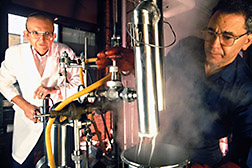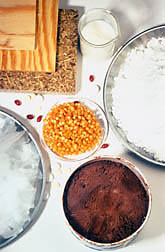|
|
A Fantesk-tic Starch-Oil Combo
Thanks to serendipity, the Midwest's two main crops, corn and soybeans, could soon find new uses in many food and nonfood products.
"Chance favored prepared minds," says Peter B. Johnsen about the development of a new fat substitute by two scientists at the National Center for Agricultural Utilization Research (NCAUR) located in Peoria, Illinois.
Johnsen, director of the NCAUR, was referring to the creation of a versatile farm-based product that has many possible food and nonfood applications.
Here's how Fantesk came about.
Two NCAUR chemists, Kenneth Eskins, in the Phytoproducts Research Unit, and George F. Fanta, in the Plant Polymer Research Unit, were interested in using membranes as model systems for making natural consumer and agrochemical products from fatty acids.
They wanted to find some means of making an artificial membrane—possibly a starch-oil copolymer—on which enzymes could form natural compounds ranging from flavorings to fungicides. As a preliminary step, they processed starch and oil together in superheated steam under pressure.
"What came out of the cooker appeared at first to be a thick, gelled mess," Eskins says.
As the gel cooled, the chemists were surprised to find the starch and oil didn't separate. Contemplating and rubbing the cooled gel between his fingers, Eskins noticed it felt smooth but not greasy.
Surely the components would separate, the scientists thought, if the gel were melted into a liquid in a microwave oven. But no. And there was no separation after freezing and thawing. Even when the gel was dried to a solid, flaky material, the oil remained microencapsulated in the starch matrix.
"That's when we began to think we might have a useful food ingredient," says Eskins.
They named this remarkable material "Fantesk."
It forms inseparable mixtures of starch and microdroplets of oil and, because the mixtures flow so easily after being dried and ground into powder, Fantesk could be a food engineer's dream.
Fantesk could also be a dieter's dream because with it, foods traditionally high in fat can be low in fat—and still taste good. For example, researchers found about the same taste and creaminess of ordinary ice cream with 8 to 10 percent fat to be in a 0.3-percent-fat ice milk made with 2 percent Fantesk.
Generally consisting of 20 to 40 parts, by weight, of vegetable oil per 100 parts of starch, Fantesk can be dried and milled into small particles. This saves the cost of transporting a water-laden product to market. And the easily flowable powder can later be redispersed in water to make soft gels for use in products such as low-fat margarines. Or, by heating, it can be converted into a pourable fluid.
A variety of potential uses has given rise to Cooperative Research and Development Agreements with several companies interested in developing market niches.
For example, Seedbiotics of Bakersfield, California, has entered into a CRADA with ARS to explore ways to incorporate microbial agents and agrichemicals into a seed coating. Another CRADA, with the Forest Resources Group of Union Camp in Savannah, Georgia, is for developing adhesives, glues, and industrial coatings.
Opta Foods of Bedford, Massachusetts, has applied for an exclusive license for food applications of Fantesk. And the ARS Office of Technology Transfer is working with several other companies on licensing agreements for nonfood applications.
The presence of oil makes Fantesk act as an emulsifying or dispersing agent, letting it mix with materials that don't themselves mix well with water. So Eskins foresees many opportunities as an ingredient in beauty and health-care products. These would include hand and body lotions and creams, bath oils, shampoos and conditioners, suntan lotions, lipsticks, eye shadows, dusting and foot powders, medicinal oils, vitamins, antibiotics, and antifungal agents.
Eskins also envisions industrial applications such as use in oil drilling muds, adhesives, paint thickeners and removers, inks, toners, polishes, paint removers, lubricants, and starch fillers for plastics.
Fantesk can be tailored to specific end uses by selecting the best processing conditions, varying the proportion of starch to oil, and regulating composition of the ingredients—for example, choosing starch high in amylose or amylopectin.
Eskins says, "Under certain conditions, we can produce a nonseparable formulation of up to 70 parts of oil by weight per 100 parts of starch." Such formulations may be useful for making dried shortenings.
Volatile oils like limonene, the principal aroma component of lemon, can be incorporated into Fantesk after it is processed into a powder. The researchers made a scratch-and-sniff pad—a thin, dried sheet from the powder and limonene mix—that released the smell of limonene whenever it was scratched, for up to several weeks.
In a similar experiment starting with a Fantesk formulation of starch, soy protein, and canola oil, researchers mixed fresh strawberries that had been processed through a blender. The film trapped the odor and flavor until scratched or broken.
Could bread be made in such a way that a just-out-of-the-oven flavor would burst forth with each new bite? "Perhaps so," says Eskins, "but we haven't worked on that one."
Eskins sees Fantesk benefiting agriculture by providing a market not only for farm commodities used in industrial and consumer products, but also for products that make farming more efficient.
For example, Fantesk could be developed as coatings laced with agrochemicals to help seeds develop into healthier, higher-yielding crop plants. Such coatings could contain fungicides, herbicides, nutrients, growth regulators, and beneficial microbes. Eskins has found that a water suspension of Fantesk adheres to seeds' natural waxy coatings and doesn't flake off easily when dried.
And speaking of seed coatings:
Why not use Fantesk as a carrier for buttery flavoring on diet popcorn?
"We microwaved some popcorn coated with Fantesk and a small amount of buttery flavor, and it tasted great," Eskins says.
Though further research is needed, a 4-ounce serving of the experimental recipe contained just 1 gram of fat. That is far less than the 10 to 15 grams in a popular microwavable low-calorie, butter-flavored commercial popcorn brand.
Eskins and Fanta have applied for a patent on making Fantesk blends of starches, fats, and water for diverse uses. — By Ben Hardin, ARS.
George F. Fanta is at the USDA-ARS National Center for Agricultural Utilization Research, 1815 N. University St., Peoria, IL 61604; phone (309) 681-6356, fax (309) 681-6691.
"A Fantesk-tic Starch-Oil Combo" was published in the September 1995 issue of Agricultural Research magazine.








